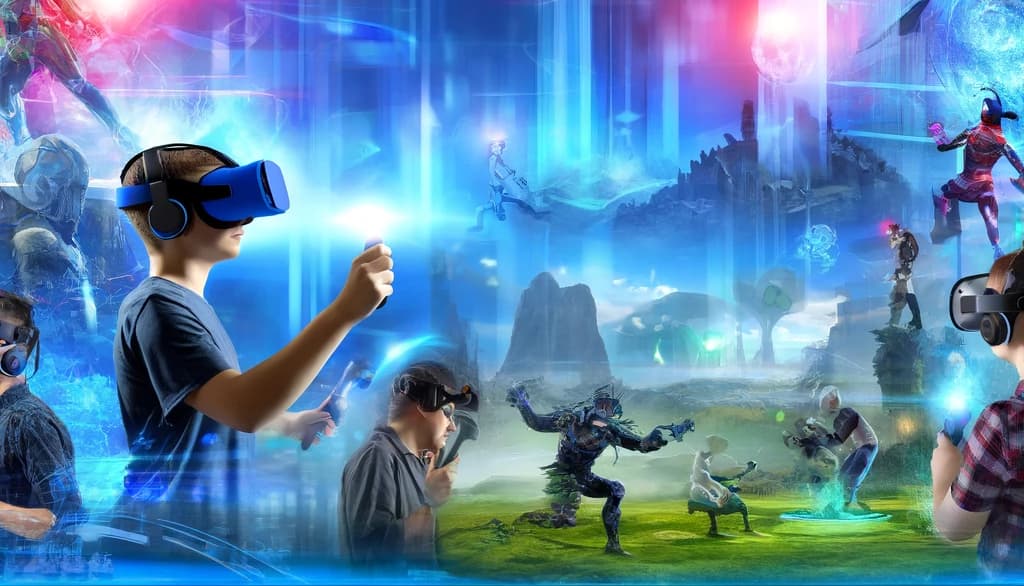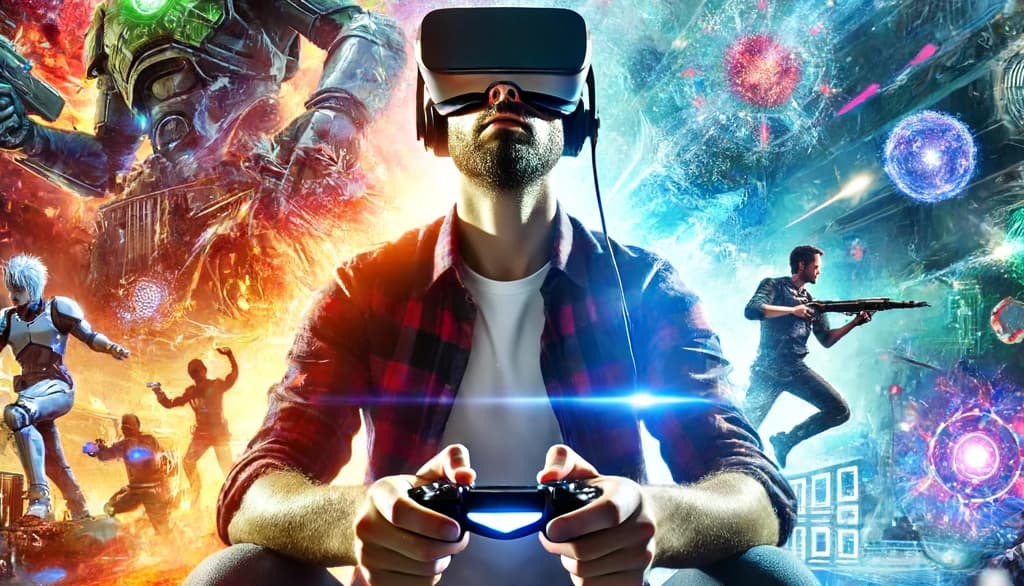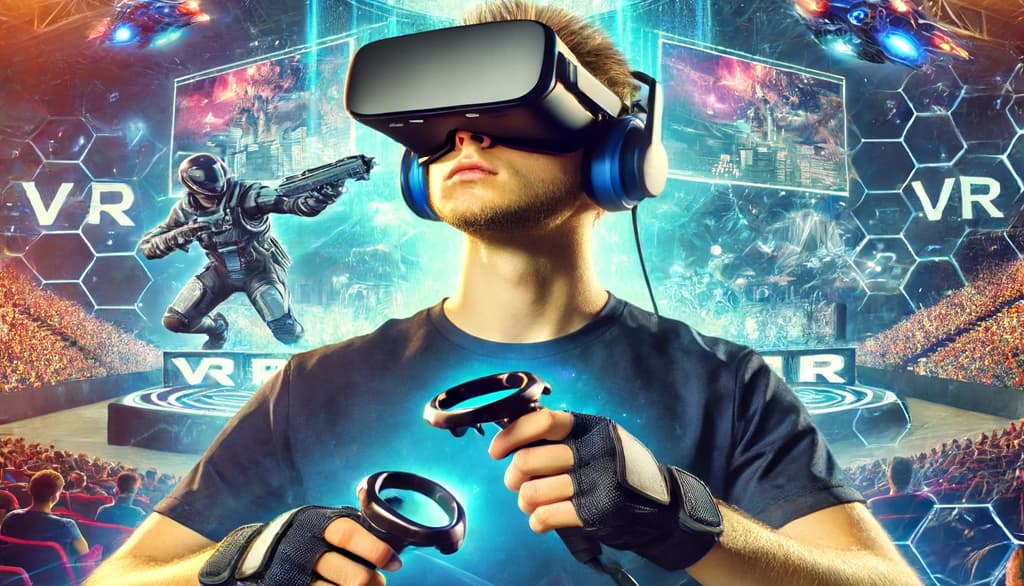
Virtual reality (VR) has revolutionized the gaming industry, offering immersive experiences that were once the stuff of science fiction. The integration of VR technology in gaming has not only transformed the way games are played but also expanded the horizons of game development and player engagement.
From the early days of VR experiments to the sophisticated systems available today, the journey of VR in gaming is a testament to technological advancement and creative innovation. This article delves into the evolution of VR technology, its impact on traditional gaming, and the future trends shaping the VR gaming landscape.
Introduction to Virtual Reality in Gaming
Virtual reality in gaming refers to the use of VR technology to create a simulated environment that players can interact with in a seemingly real or physical way. This technology utilizes headsets, motion sensors, and advanced graphics to provide an immersive gaming experience.
Initially introduced in the late 20th century, VR gaming has seen substantial growth and development. Modern VR systems offer high-resolution displays, precise motion tracking, and a wide range of games, making it a popular choice among gamers worldwide.
The Evolution of VR Technology
The journey of VR technology began with basic simulators and prototypes in the 1960s and 70s. Early VR systems were bulky and expensive, limiting their accessibility. However, technological advancements over the decades have made VR more affordable and user-friendly.
Significant milestones include the introduction of the Oculus Rift, the HTC Vive, and Sony’s PlayStation VR. These devices have set new standards for VR gaming, providing enhanced visual fidelity, interactivity, and comfort. Continuous innovations in VR hardware and software promise even more sophisticated experiences in the future.
Key Players in the VR Gaming Industry
The VR gaming industry is dominated by several key players who have significantly contributed to its growth. Companies like Oculus (owned by Meta), HTC, and Sony are at the forefront, offering cutting-edge VR headsets and platforms.
These companies not only produce hardware but also collaborate with game developers to create exclusive VR content. Other notable players include Valve, known for its SteamVR platform, and Microsoft, with its Mixed Reality initiative, both of which have expanded the VR gaming ecosystem.
Impact of VR on Traditional Gaming
VR has introduced a new dimension to traditional gaming, offering immersive experiences that conventional gaming platforms cannot match. This shift has led to the development of new game genres and the adaptation of existing ones for VR.
Traditional gaming benefits from VR by enhancing player engagement and providing more interactive storytelling. However, it also poses challenges, such as the need for powerful hardware and the development of user-friendly VR interfaces.
Immersive Experiences: What VR Brings to the Table
VR gaming is synonymous with immersion, offering players a sense of presence within the game world. This is achieved through advanced graphics, 3D audio, and interactive environments that respond to player actions in real-time.
Key features of VR gaming include lifelike simulations, spatial audio, and haptic feedback, which collectively enhance the gaming experience. These elements make VR games more engaging and realistic, providing players with unique and memorable experiences.

Popular VR Gaming Platforms
Several VR gaming platforms have gained popularity due to their robust ecosystems and extensive game libraries. Oculus Quest and Rift, HTC Vive, and PlayStation VR are among the most widely used platforms, each offering distinct features and experiences. These platforms support a variety of games, from action and adventure to puzzle and simulation, catering to different player preferences. Additionally, platforms like SteamVR provide a centralized hub for VR content, enhancing accessibility and discoverability for gamers.
The Oculus Quest series, known for its wireless capabilities and standalone functionality, has made VR more accessible to a broader audience. HTC Vive offers high-end VR experiences with precise motion tracking and room-scale play, appealing to hardcore gamers and enthusiasts. PlayStation VR, compatible with the PlayStation console, provides a cost-effective entry point into VR gaming, making it a popular choice for console gamers. These platforms continuously evolve, with new iterations and updates enhancing the VR experience.
VR Game Development: Tools and Techniques
Developing VR games requires specialized tools and techniques to create immersive and interactive experiences. Game engines like Unity and Unreal Engine are commonly used for VR development, offering robust frameworks and extensive libraries. These engines provide developers with the necessary tools to create realistic environments, complex interactions, and detailed graphics, essential for an engaging VR experience.
Techniques such as 3D modeling, motion capture, and VR-specific UI design are crucial for creating immersive VR games. Developers often use 3D modeling software like Blender or Maya to create detailed game assets. Motion capture technology helps in recording realistic movements, which are then integrated into the game. VR-specific UI design focuses on creating intuitive and user-friendly interfaces that enhance the player’s experience. Additionally, optimizing performance to ensure smooth gameplay and reduce motion sickness is a key focus in VR game development.
Challenges and Limitations of VR Gaming
Despite its advantages, VR gaming faces several challenges and limitations. High costs of VR hardware and the need for powerful computers are significant barriers to widespread adoption. The price of VR headsets, coupled with the requirement for high-end PCs or consoles, limits access for many potential users. Additionally, the setup complexity and space requirements for some VR systems can be a deterrent.
Issues like motion sickness and limited content availability can also affect user experience. Motion sickness, caused by a disconnect between visual and physical movement, can make VR gaming uncomfortable for some players. The relatively limited library of high-quality VR games compared to traditional gaming further restricts its appeal. Developers and manufacturers are continually working to address these challenges by creating more affordable VR systems, enhancing comfort, and expanding game libraries. Overcoming these obstacles is crucial for the future growth of the VR gaming industry.
Future Trends in VR Gaming
The future of VR gaming looks promising, with several trends indicating further growth and innovation. Advancements in VR hardware, such as wireless headsets and improved motion tracking, are expected to enhance the user experience. Next-generation VR headsets are likely to offer higher resolution displays, wider fields of view, and better ergonomics, making VR gaming more immersive and comfortable.
Emerging technologies like augmented reality (AR) and mixed reality (MR) are also influencing the VR landscape, offering new possibilities for game development. AR and MR can blend virtual elements with the real world, creating hybrid experiences that extend the potential of VR. Additionally, increased investment in VR content and the rise of social VR platforms are set to drive the industry’s evolution. Social VR platforms enable users to interact in virtual environments, fostering community and collaboration. These trends suggest a dynamic future for VR gaming, with continuous innovation and expanding opportunities.
VR and Esports: A New Frontier
VR is making significant inroads into the esports scene, offering new opportunities for competitive gaming. VR esports provide immersive and physically engaging experiences, attracting both players and spectators. Games such as Echo Arena and Onward have gained popularity in the VR esports arena, showcasing the potential for high-stakes, competitive VR gaming.
Tournaments and leagues dedicated to VR games are emerging, showcasing the potential of VR in esports. These events not only highlight the skill and dexterity required for VR gaming but also offer a new dimension of viewer engagement, with spectators able to experience the game from the player’s perspective. This trend is expected to grow, with more VR titles being developed specifically for competitive play and esports organizations investing in VR teams and infrastructure.

Betwinner and Its Providers in the VR Space
Betwinner, a well-known name in the online gaming industry, has ventured into the VR space, partnering with leading providers to offer VR gaming experiences. These partnerships aim to deliver high-quality VR content, enhancing the platform’s offerings. By incorporating VR games, Betwinner App is not only expanding its game library but also appealing to a tech-savvy audience looking for immersive gaming experiences.
The inclusion of VR games on Betwinner platform provides users with immersive gaming options, reflecting the growing trend of VR adoption in the online gaming sector. This move highlights Betwinner commitment to staying at the forefront of gaming innovations. Collaborations with VR content creators and developers ensure a diverse and engaging selection of VR games, from immersive casino experiences to action-packed adventures.
User Adoption and Market Growth
User adoption of VR gaming has been steadily increasing, driven by the availability of affordable VR headsets and compelling game content. The market for VR gaming is projected to grow significantly in the coming years, with more players embracing this technology. Factors contributing to this growth include advancements in VR hardware, increased investment in VR content, and the rising popularity of VR esports. As the technology continues to evolve, VR gaming is expected to become a mainstream entertainment option.
Surveys and market analysis indicate a positive trend in VR adoption, with a growing number of gamers expressing interest in VR experiences. Companies are responding by producing more user-friendly and cost-effective VR systems, making the technology accessible to a broader audience. The potential for VR to revolutionize other sectors, such as education and training, further underscores its market potential and versatility.
Conclusion: The Future of VR in Gaming
The rise of virtual reality is transforming the gaming landscape, offering immersive and interactive experiences that were once unimaginable. As VR technology continues to advance, its impact on gaming is set to deepen, creating new opportunities and challenges for the industry. The integration of VR in various gaming genres, the expansion of VR esports, and the ongoing development of more sophisticated VR hardware and software are key indicators of this transformation.
With continuous innovation and growing user adoption, the future of VR in gaming looks bright. This exciting journey is just beginning, and the possibilities for VR gaming are limitless, promising a dynamic and evolving landscape for years to come. As the gaming community and technology developers collaborate, VR gaming will likely become an integral part of the broader entertainment ecosystem, offering experiences that captivate and engage players worldwide.